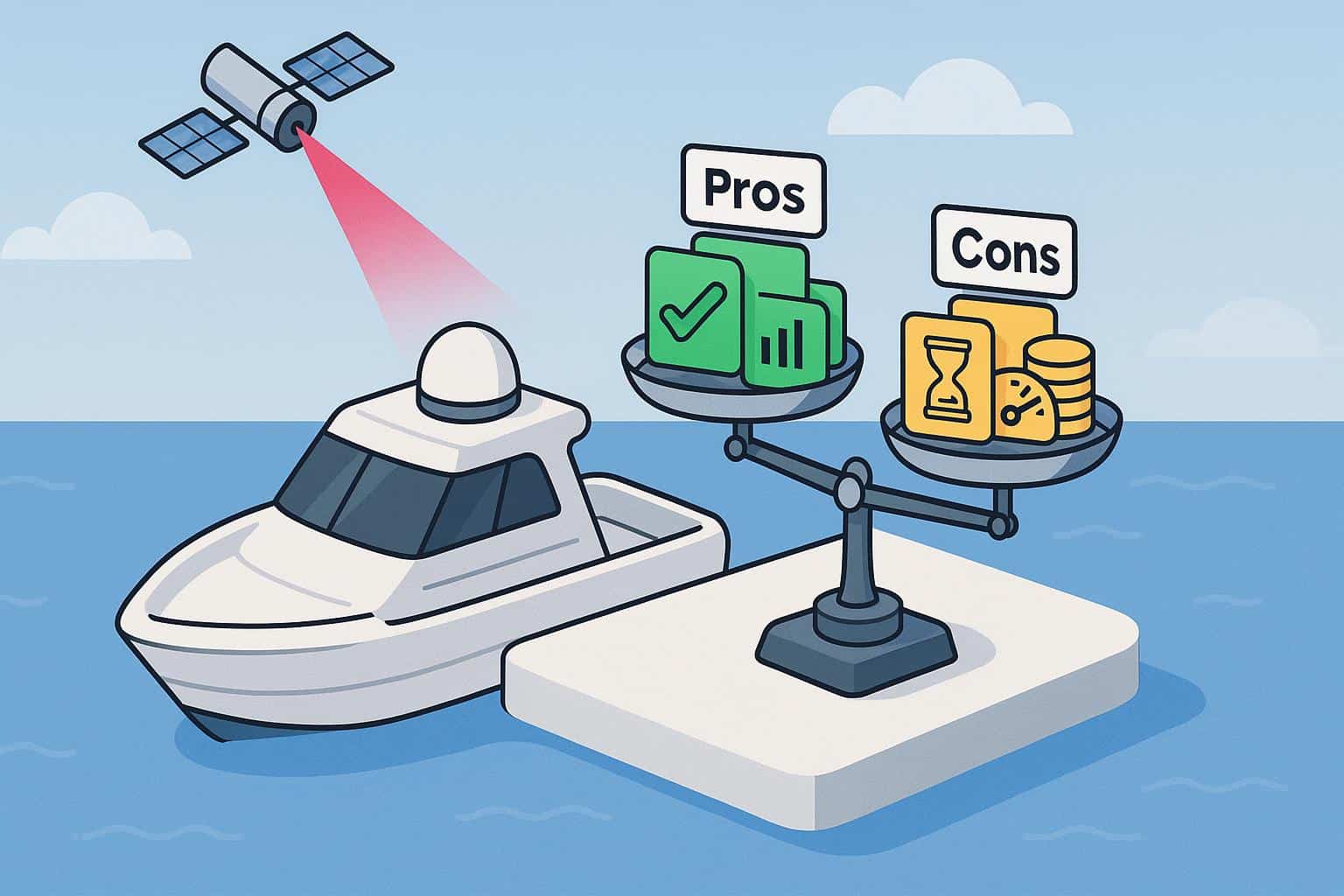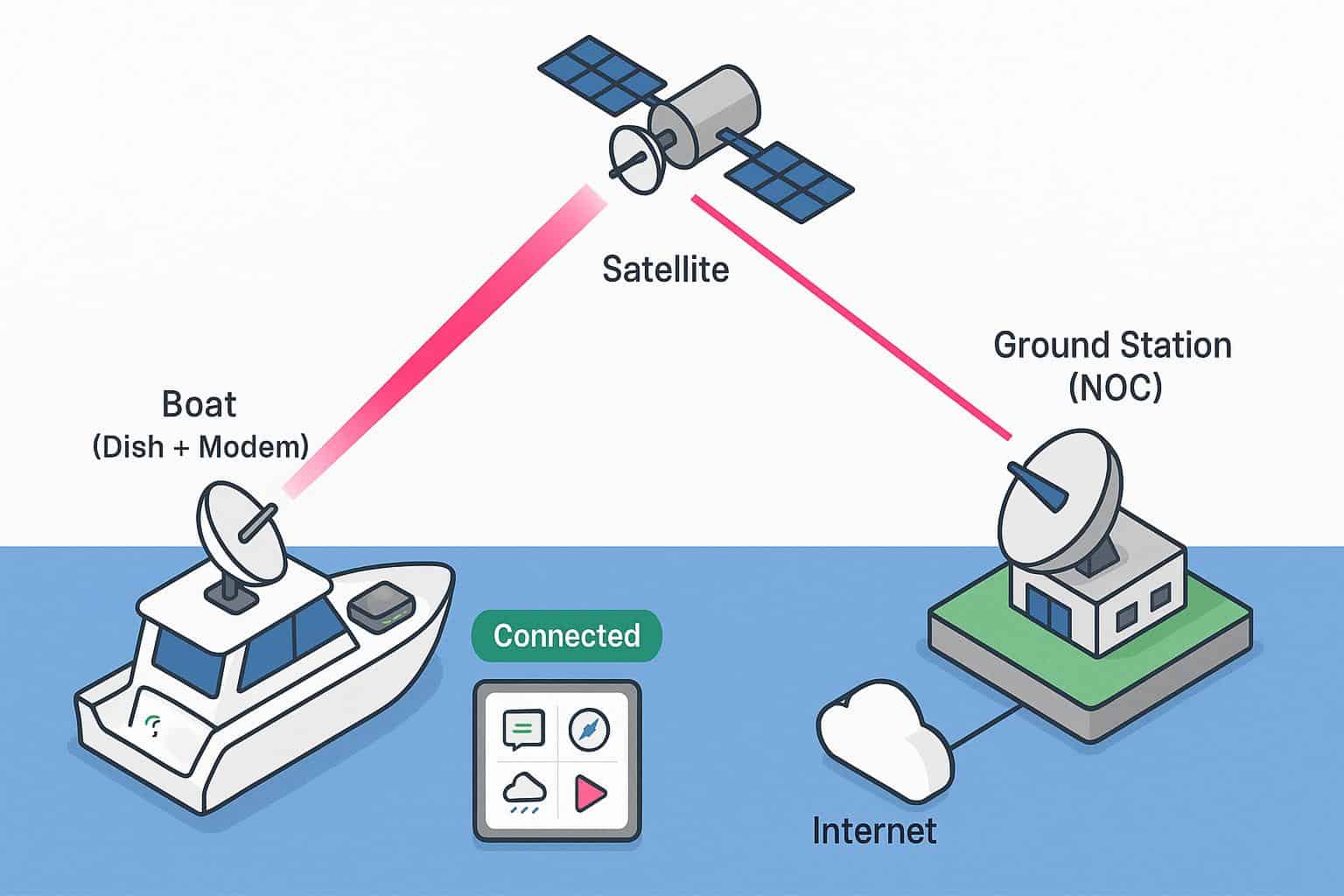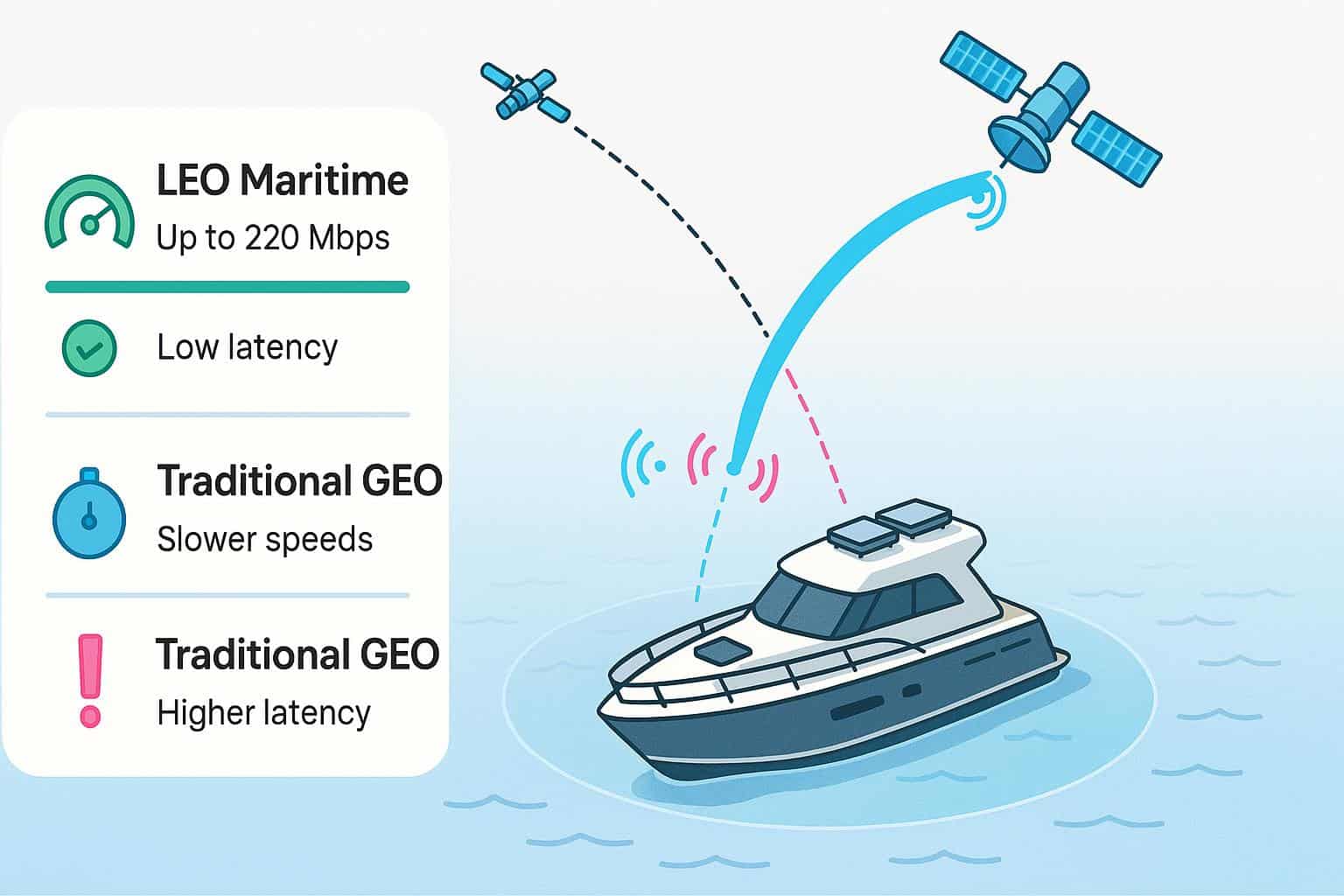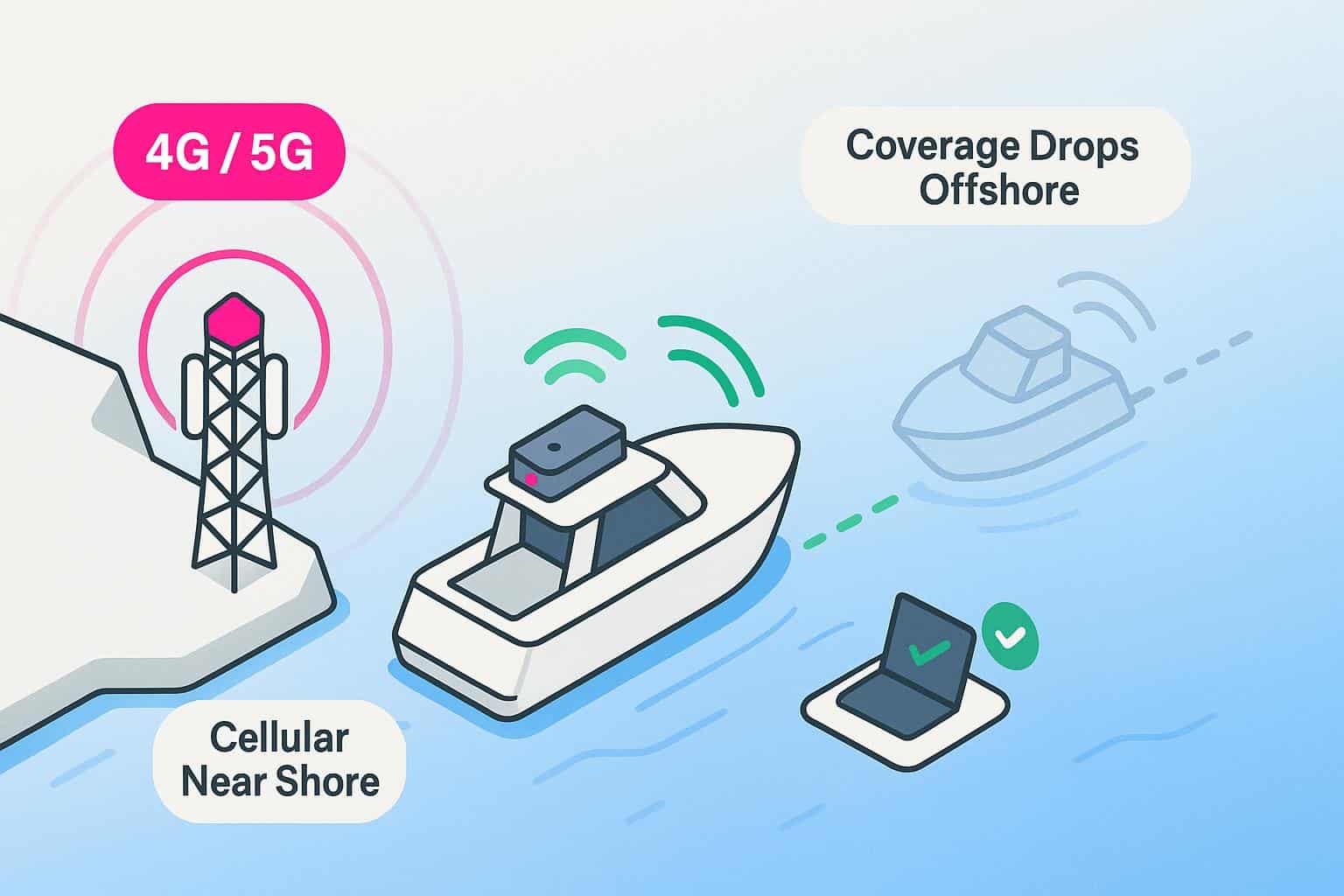Everything to Know About Satellite Internet for Boats
Starlink is the ideal option, providing faster download speeds than traditional satellite internet providers.

- Boaters need reliable internet for navigation, communication and entertainment, especially in open waters.
- Starlink’s Maritime plan is a leading provider for boaters, offering speeds of 400 Mbps or more under ideal conditions, global coverage and reduced latency at a reasonable price.
- Cellular providers can serve as an alternative to satellite internet, but they come with significant limitations.
We live in a constantly connected world, and sometimes, unplugging isn’t an option. Internet access is no longer a luxury, but a necessity, no matter where you find yourself. If you love boating and exploring the open sea, you still need the internet to stay connected, whether you need it for navigational purposes or to keep in touch with family and friends. Satellite internet stands out as the best internet option for boats. In this guide, we take a deep dive into satellite internet for boats, examining providers, the technology used, costs and more.
Table of Contents
- What Is Satellite Internet and How Does It Work?
- Pros and Cons of Satellite Internet
- What Equipment Do You Need for Satellite Internet?
- Satellite Internet Providers for Boats
- Alternate Internet Options for Boats
What Is Satellite Internet and How Does It Work?

Satellite internet allows boats to access reliable internet by transmitting data between a dish antenna and a satellite orbiting Earth. The satellite communicates with a network operations center on land, which is connected to the internet. Onboard, a satellite modem converts these signals into internet data and back again. As long as the antenna has an unobstructed view of the sky, this technology makes it possible to stay connected, even miles away from shore.
For those navigating open waters, satellite internet is a game-changer. Traditional wired internet options like cable or fiber are unavailable at sea, leaving satellite internet as the primary solution for connectivity. This technology ensures access to communication tools, navigation systems, weather updates and entertainment, all of which are crucial for safety and convenience while boating. Recent advancements in satellite technology have significantly enhanced connection speeds and reduced latency, making it more practical for maritime use.
Pros and Cons of Satellite Internet
Weighing the pros and cons of satellite internet helps you decide if satellite internet is the best option for your boating needs. While it offers reliable connectivity at sea, its practicality depends on your travel habits and priorities.
Pros
- Global coverage
- Can offer a reliable connection
- Flexibility
- Aids in navigation
Cons
- Potential for high latency
- High cost
- Weather can negatively impact signal
- Bandwidth limitations
What Equipment Do You Need for Satellite Internet?

Life on the water requires simplifying your setup and prioritizing essential equipment. For satellite internet access on your boat, typically, you’ll need to have the following onboard:
- Satellite dish and/or antennas: A marine-grade stabilized dish that can track satellites even as the boat moves.
- Satellite modem: Converts satellite signals into internet data and vice versa.
- Antenna Control Unit (ACU): Manages and controls the satellite antenna to maintain alignment with the satellite.
- Router: Distributes the internet connection wirelessly to multiple devices on the boat.
- Power supply: A reliable power source to operate the equipment, typically through the boat’s electrical system.
- Mounting hardware: Secure brackets and mounts to install the satellite dish or antenna on the boat.
- Cables: High-quality coaxial cables to connect the satellite dish, modem and ACU.
Satellite Internet Providers for Boats

While you have a few options for satellite internet, Starlink’s Maritime plan stands out as a leading choice. Offered by SpaceX, Starlink’s low Earth orbit (LEO) satellite network provides fast, reliable internet with significantly reduced latency compared to traditional satellite providers. The Maritime plan offers speeds of 400 Mbps or more (under ideal conditions), making it ideal for communication, navigation, streaming and other online activities while at sea. With coverage extending across U.S. coastal waters and beyond, Starlink has quickly become a game-changer for boaters seeking reliable connectivity at sea.
Traditional providers like Inmarsat, owned by Viasat, remain available for maritime internet in the U.S., but they often come with higher costs, slower speeds and greater latency. Starlink Maritime offers a more competitive solution, with hardware specifically designed for marine use and a streamlined installation process. U.S. boaters, whether you’re a coastal cruiser or offshore adventurer, will find that Starlink Maritime delivers the performance and affordability needed to stay connected while navigating the open seas.
Here’s a head-to-head of satellite internet plans for boaters:
| Provider | Monthly cost | Download speeds | Upload speeds | Unlimited Data |
|---|---|---|---|---|
| Starlink | Starting at $250 | 400 Mbps or more under ideal conditions | Varies | No |
| Inmarsat* | Flat fee (undisclosed) | Up to 340 Mbps | 70–80 Mbps | Yes |
*Based on NexusWave, Inmarsat’s newest service.
Alternate Internet Options for Boats

For boaters looking for alternatives to satellite internet, cellular-based solutions are the most common option. Cellular hotspots or modems can provide fast and reliable internet near shore, utilizing 4G or 5G networks from providers such as Verizon, AT&T or T-Mobile. However, coverage is limited to areas within range of cell towers, which means connectivity drops off significantly as you venture further offshore. This option could be ideal for coastal cruising or trips within proximity to populated areas where cellular signals are strong.
Frequently Asked Questions About Satellite Internet for Boats
What is the downside of Starlink?
Starlink offers excellent speeds and low latency, but its service relies on a clear view of the sky. Any inclement weather, including heavy rain or obstructions, can disrupt connectivity. Another concern is power consumption, as the hardware requires a strong power source, which can be challenging on smaller boats.
Why is Starlink Maritime so expensive?
Starlink Maritime’s high cost reflects the advanced technology and infrastructure required to provide reliable, high-speed internet at sea. The specialized marine hardware is designed to maintain a stable connection even on moving vessels in open water.
How far off the coast does Starlink work?
Starlink Maritime provides connectivity far beyond the coast, offering coverage in most open-water areas worldwide. By comparison, Starlink’s Roam plan only reaches 12 nautical miles offshore.
Can you use mobile data on a boat?
While you can use mobile data on a boat, it’s limited by proximity to cellular towers. 4G and 5G networks provide reliable speeds for browsing, streaming and communication near the shore. However, as you move farther offshore, the signal weakens and eventually disappears.
Do cell phones work on boats?
Cell phones work on boats as long as they are within range of cellular towers. In coastal waters, you can make calls, send texts, and use mobile data without issues. However, the signal becomes weaker the farther you are from shore, and it may drop entirely in remote areas.
How far offshore will your cell phone work?
Cell phone coverage offshore varies depending on the strength of the coastal network and your carrier, but generally extends up to 12–15 miles. Factors like tower placement, terrain, and weather conditions can impact signal range. Beyond this distance, signals become weak or non-existent.